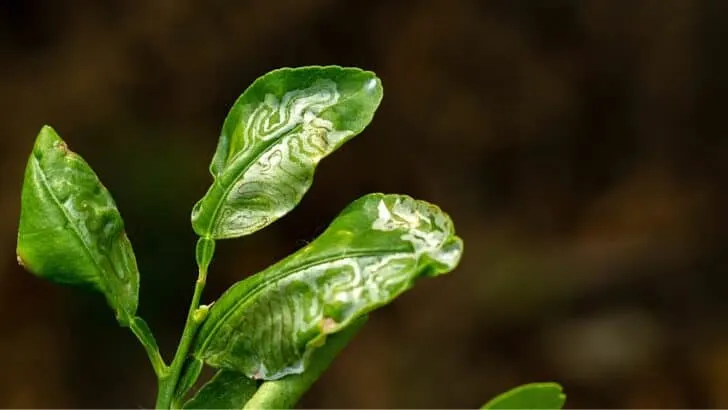It is always unsightly when bumps appear on the leaves of a tree.
Some lumps and knobbly growths are largely a cosmetic issue, while others, such as certain varieties of leaf gall and some bacterial infections, pose a serious risk to the health of affected trees.
It is important to identify what is affecting your lemon tree as soon as you notice bumps appearing on its leaves.
In some cases, bumps may be caused by something eating your lemon tree leaves, while in other cases they may be caused by a bacterial or fungal infection.
Even in the least harmful cases, bumps can lead to lemon tree leaves curling, which slows a tree’s ability to absorb sunligh and hinders photosynthesis.
In the worst cases, lumps can mean your lemon tree is beyond saving and must be destroyed.
Read on for a clear and comprehensive guide to the most common reasons why lemon tree leaves develop bumps and instructions for how to handle the different conditions that may be affecting them.
What are the bumps on the leaves of my lemon tree?
The bumps on the leaves of your lemon tree could be citrus cankers, greasy spot fungus, or citrus galls. Galls are the most common reason for bumps on lemon tree leaves. Galls don’t kill lemon trees, but they can cause tree limbs to die back and inhibit fruit growth.
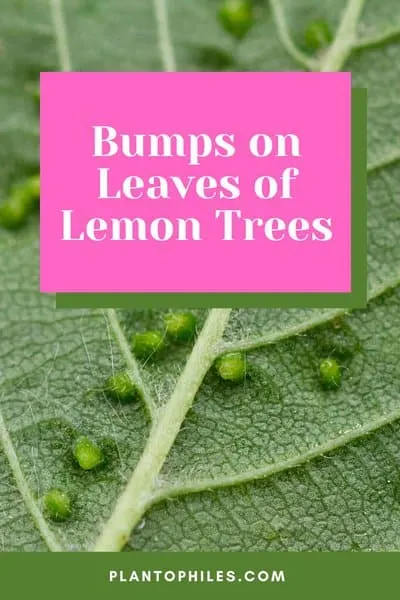
While citrus cankers and greasy spot fungus can certainly cause problems for lemon tree owners, bumps on the leaves of lemon trees are usually caused by female citrus galls wasps laying eggs inside the leaf tissue and branches.
Fortunately, unlike citrus cankers, galls can usually be controlled and don’t have to mean the end of your lemon tree’s days as a fruit-bearing tree.
Here is a run-through of the three most common causes of bumps on lemon tree leaves, including how to identify them, an explanation of what causes them, and recommendations for treatment or control.
1. Citrus Cankers
Citrus cankers are yellow, halo-shaped lesions caused by bacterial infections that spread through the air.

How Harmful Citrus Cankers are
Citrus cankers are very harmful.
Unfortunately, once a lemon tree has citrus cankers, there is no way to save it and it will have to be cut down.
Identification
You can determine whether the bumps on the leaves of your lemon tree are citrus cankers by checking the twigs and fruits of your tree.
If they have similar lumps on them, then you can be almost certain that your tree has a bacterial infection.
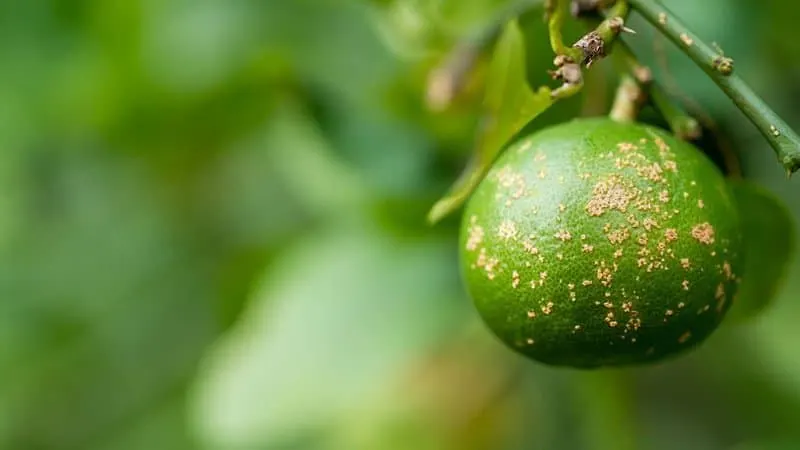
More severe symptoms of lemon cankers include leaf curl and fruit loss.
If your tree is losing its leaves, consider looking into common reasons and remedies for leaf drop on lemon trees.
Treatment
There is no way to treat citrus cankers. The tree will have to be removed from your garden or orchard and disposed of.
However, you can prevent citrus cankers from occurring in the first place by using a liquid copper fungicide in the early spring.
If you need assistance removing an affected lemon tree, look into how to hire a tree care professional.
2. Greasy Spot Fungus
Greasy spot fungus causes brown blister-like bumps to grow underneath lemon tree leaves.
Airborne spores of Mycosphaerella citri settle and then grow in the decomposing leaves under citrus trees.
They then rise up through the air and infect the new leaves.
Level of Harm
Greasy spot fungus is largely a cosmetic issue. You do not need to be too worried if your lemon tree has greasy spot fungus.
That said, you still need to identify the problem and then treat it effectively so that it doesn’t harm your tree or damage your crop unnecessarily.
Identification
If there are bumps on the underside of your lemon tree leaves that resemble brown blisters, then your tree almost surely has greasy spot fungus.
Treatment
Fortunately, greasy spot fungus is relatively easy to treat.
All you need to do is apply liquid copper fungicide to the leaves and branches of the affected tree. Apply it once in the early summer and then again in the early autumn.
This should effectively clear the fungus.
Clearing leaves from under your lemon tree regularly will help prevent the problem from arising in the first place.
3. Citrus Galls
Citrus galls appear on the leaves of lemon trees when galls wasps lay their eggs in budding leaf tissue.
The growth has a woody texture and is encasing the wasp larvae that have been left by the mother gall wasp.

The wasps themselves are only 3 millimeters long, but they can wreak havoc on the appearance of lemon trees.
Level of Harm
Citrus galls are not life-threatening to lemon trees.
However, your lemon tree will be happier if you take the appropriate steps to get rid of the galls, which can lead to leaf curl and drop if left untreated.
Identification
Citrus galls are swollen areas on the stems of lemon tree leaves and branches. They resemble hard, inflated, green lumps.
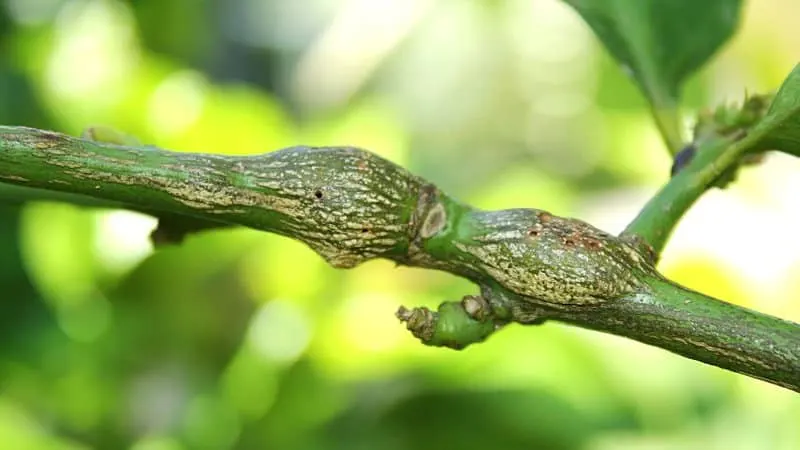
Treatment
Pruning is one of the most effective ways in treating your lemon tree infected with the citrus leaf gall.
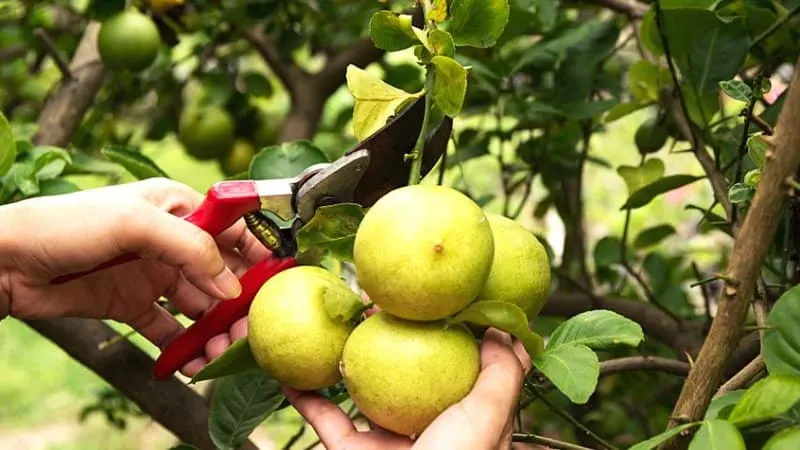
The minute you see a gall appear on the leaves or twigs of your lemon tree, get out your clippers and snip off the affected leaves.
The most important thing to do if a lemon tree has galls is to prune away any affected leaves and branches in advance of early spring when the new leaves emerge.
Dispose of the trimmings by bagging them up inside a trash bag before putting them in the general trash.
If your tree is badly affected, you can slice open the individual leaf galls instead of trimming off whole leaves or branches. This will dry out the larvae inside.
If pruning doesn’t seem to be working, you may have to revert to chemical controls as a last resort.
If you know you are growing lemon trees in an area affected by citrus gall wasps or know that a tree has previously struggled with galls, you could take preventative steps to stop them from developing in the first place.
Preventative measures include limiting the amount of fertilizer you use on your lemon trees in the early spring. The more you fertilize your trees, the more new leaf growth they will produce.
Also, try to avoid using high-nitrogen fertilizers when possible and opt for organic ones instead.
Applying natural horticultural oils on budding lemon tree leaves as soon as they emerge will prevent gall wasps from settling on the new growth.
Look into how to apply neem oil to houseplants if your lemon tree is just a little companion you keep indoors.

Daniel has been a plant enthusiast for over 20 years. He owns hundreds of houseplants and prepares for the chili growing seasons yearly with great anticipation. His favorite plants are plant species in the Araceae family, such as Monstera, Philodendron, and Anthurium. He also loves gardening and is growing hot peppers, tomatoes, and many more vegetables.

